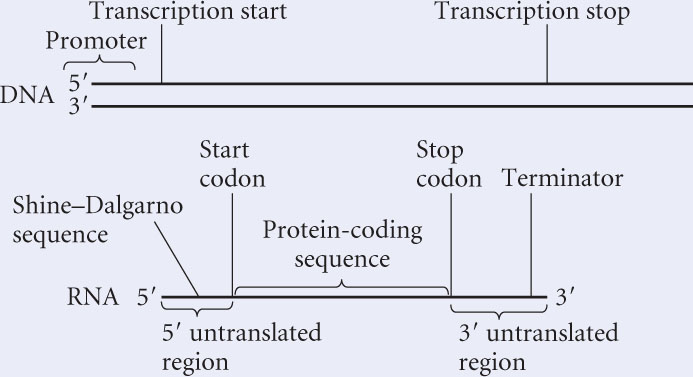Answers to Concept Checks
- 1. When DNA was hybridized to the mRNA transcribed from it, regions of DNA that did not correspond to RNA looped out.
- 2. Group I introns, group II introns, nuclear pre-mRNA introns, and transfer RNA introns.
- 3. A protein that adds the 5′ cap is associated with RNA polymerase II, which transcribes pre-mRNAs but is absent from RNA polymerase I and III, which transcribe rRNA and tRNAs.
- 4. b
- 5. c
- 6. Guide RNA
- 7. b
- 8. d
- 9. An siRNA or miRNA combines with proteins to form RISC, which then pairs with mRNA through complementary pairing between bases on the siRNA or miRNA and bases on the mRNA.
WORKED PROBLEMS
Problem 1
DNA from a eukaryotic gene was isolated, denatured, and hybridized to the mRNA transcribed from the gene; the hybridized structure was then observed with an electron microscope. The adjoining structure was observed.

- a. How many introns and exons are there in this gene? Explain your answer.
- b. Identify the exons and introns in this hybridized structure.
407
Solution Strategy
What information is required in your answer to the problem?
 The number of introns and exons and how you arrived at your answer.
The number of introns and exons and how you arrived at your answer. The location of the introns and exons labeled on the figure.
The location of the introns and exons labeled on the figure.
What information is provided to solve the problem?
 The DNA and mRNA are from a eukaryote.
The DNA and mRNA are from a eukaryote. The DNA was denatured and hybridized to the mRNA.
The DNA was denatured and hybridized to the mRNA. A picture of the hybridized structure.
A picture of the hybridized structure.
For help with this problem, review:
Introns in Section 14.1 and Figure 14.2.
Solution Steps
- a. Each of the loops represents a region in which sequences in the DNA do not have corresponding sequences in the RNA; these regions are introns. There are five loops in the hybridized structure; so there must be five introns in the DNA and six exons.
Recall: Introns are noncoding sequences found within eukaryotic genes.
- b.

Hint: The number of introns will be one less than the number of exons.
Problem 2
Draw a typical bacterial mRNA and the gene from which it was transcribed. Identify the 5′ and 3′ ends of the RNA and DNA molecules, as well as the following regions or sequences:
- a. Promoter
- b. 5′ untranslated region
- c. 3′ untranslated region
- d. Protein-coding sequence
- e. Transcription start site
- f. Terminator
- g. Shine–Dalgarno sequence
- h. Start and stop codons
Solution Strategy
What information is required in your answer to the problem?
A drawing of the mRNA and gene from which it is transcribed. The 5′ and 3′ ends of the mRNA and DNA molecules. Locations of the listed structures on the drawing.
What information is provided to solve the problem?
 The gene is from a bacterium.
The gene is from a bacterium. Different parts of the DNA and RNA that are to be labeled.
Different parts of the DNA and RNA that are to be labeled.
For help with this problem, review:
The Template in Section 13.2 and The Structure of Messenger RNA in Section 14.2.
Solution Steps

Hint: Review the structure of a transcription unit in Figure 13.6 and the structure of mRNA in Figure 14.5.
408